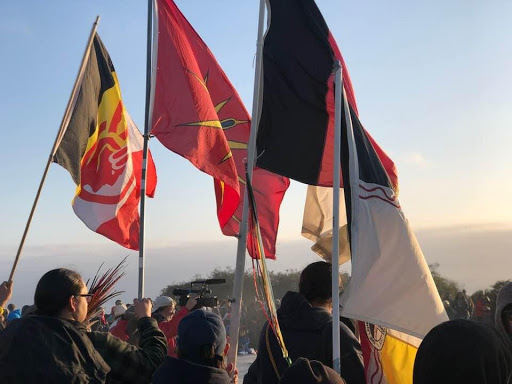
- Details
- By Wakinyan LaPointe, Sicangu Lakota
OPINION. We have reached an unprecedented moment in history and for the first time ever, humans have induced what some are calling the 6th mass extinction, an event which will ripple out across biodiversity, ecosystems, and aquatic regions for generations to come. Projections include rates of species extinction, one hundred times higher, due to human activity and accelerated by centuries of colonialism. Indigenous Peoples’ Day amplifies the profound and powerful call to a higher consciousness by Indigenous Peoples and youth who continue to be the first line of defense for Unci Maka (Grandmother Earth).
For the most part, mainstream society touts western scientific approaches, technology, and experts in ivory towers. However, as the future draws nearer, more and more global actors, communities, and organizations are now looking to Indigenous Peoples for guidance.
There are 375 million Indigenous Peoples who account for 5,000 of the world’s 7,000 languages, and above 80 percent of its cultural diversity. Indigenous Peoples are distinguished as communities and Nations with ancient histories, cultures, languages, and knowledge systems which are tied to their ancestral territories
Today, studies show Indigenous cultural diversity increases biodiversity. In the same vein, Indigenous cultural survival depends on ecological survival, vice versa. When Indigenous rights are respected and protected, rates of ecological survival, carbon storage, water sustainability, reforestation, and the benefits of Indigenous stewardship increase.
While the western thinker has coined environmental approaches like: green footprint, green infrastructure, green technology, green approaches, and the green new deal, they still have the tendency to ignore the oldest Nations of the world, Indigenous Peoples.
The greenest footprint, jurisprudence, infrastructure, and approaches in the world belong to Indigenous Peoples. In fact, Indigenous water governance, jurisprudence, and environmental approaches are the oldest in existence, and have been field tested since time immemorial, surviving colonialism and genocide. The resilience of Indigenous environmental approaches spans generations. Today, Indigenous Peoples have enabled 80 percent of the world’s richest and rarest biodiversity across land and water.
As the water wars loom and Wall Street sets its sights on the water market, increased water privatization will be exacerbated by projections of water scarcity issues which will impact as much as 5 billion people by 2050—half the world’s projected population of 10 billion (United Nations).
When Indigenous Peoples and Nations first introduced the human right to water, the Law of Mother Earth, the legal personality of water, it set a precedence for the future. Indigenous jurisprudence in some cases has led to the codification of standards and laws which promote ecological sustainability and conservation in the spirit of Indigenous knowledge. For the first time, law recognized the sacredness and sanctity of Unci Maka. When Indigenous Peoples brought about the Declaration on the Rights of Indigenous Peoples, Unci Maka was codified into the human existence.
My misun (brother), Thorne, once said regarding the Indigenous future, “you don’t have to look far for implementation, all you have to do is look in the mirror.” The same holds true for the global community, we do not have to look far to know where to start with global transformation.
Indigenous Peoples are leading the implementation of a global future which honors Unci Maka, water, and all life. They stand at the forefront of environmental protection. They represent the first and original line of defense for Unci Maka. Indigenous knowledge, technology, and science are being rescaled at unprecedented levels in responding to the global crisis, climate change, and global warming. By sheer Indigenous ingenuity and innovation, the Indigenous call to higher consciousness is being heard. Now is the time.
Wopila Tanka (Immeasurable Thanks) to the Indigenous Peoples and youth who have and continue to defend Unci Maka. Who in the world’s history, have been imprisoned, abused, and killed for defending Grandmother Earth. Remembering and honoring Indigenous Peoples, youth, and Movements on this Indigenous Peoples’ Day and each day after with our songs, dances, stories, and renewed commitment.
A picture containing person, outdoor, person, glassesDescription automatically generated
Wakinyan Skye LaPointe is Sicangu Lakota, an Indigenous Human Rights advocate, and Co-Convener of the Mni Ki Wakan: Indigenous Water Decade. He centers Lakota knowledge, language, and ways of life in his work across human rights, working in partnership with Indigenous Peoples and youth.
Help us defend tribal sovereignty.
At Native News Online, our mission is rooted in telling the stories that strengthen sovereignty and uplift Indigenous voices — not just at year’s end, but every single day.
Because of your generosity last year, we were able to keep our reporters on the ground in tribal communities, at national gatherings and in the halls of Congress — covering the issues that matter most to Indian Country: sovereignty, culture, education, health and economic opportunity.
That support sustained us through a tough year in 2025. Now, as we look to the year ahead, we need your help right now to ensure warrior journalism remains strong — reporting that defends tribal sovereignty, amplifies Native truth, and holds power accountable.
 The stakes couldn't be higher. Your support keeps Native voices heard, Native stories told and Native sovereignty defended.
The stakes couldn't be higher. Your support keeps Native voices heard, Native stories told and Native sovereignty defended.
Stand with Warrior Journalism today.
Levi Rickert (Potawatomi), Editor & Publisher
